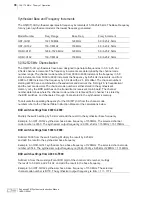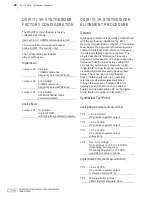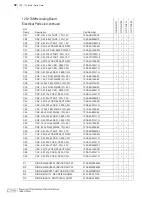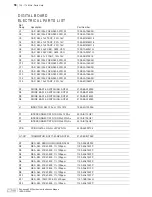
Enhanced FM Synthesizer Instruction Manual
IM10-OS3AH
128-174 MHz - Synthesizer Alignment
42
JUMPER CONFIGURATION
The synthesizer’s surface mount solder
jumpers are clearly marked on both of it’s
digital and analog circuit boards. Refer
to the ‘Digital Board Component Layout
(Bottom)’ diagram in this section and the
‘Analog Board Component Layout (Top)’
diagram for jumper locations. The following
list details the required jumper confi guration
for the two synthesizer operating modes:
1) Internal reference. Install jumper JU1 in the B
position, on the Analog Board (Standard). The
internal temperature compensated crystal
oscillator (TCXO) provides the reference
signal with a stability of ±1 ppm from -30°C
(Optional -40°C) to +60°C.
2) External reference input. Install jumper JU1
in the A position on the Analog Board. This
mode is used in applications requiring better
than ±1 ppm frequency stability. An external
reference signal must be provided at the
synthesizer’s SMB connector J1. An optional
front panel external reference connector is
available as an option for transmitters and
receivers.
3) Reference Frequency Select. Install jumper
JU2 on the Digital Board to select a 10.0MHz
reference frequency. When not installed, the
reference frequency is by default 9.6MHz.
JU2 is used by the microcontroller to establish
the correct reference frequency division ratio.
(the Synthesizer module must be removed to
change jumper JU2 on the digital board.)
Note: Care must be exercised when reinstalling
the synthesizer module on the Transmitter
Main board or the IF/Audio board. Pay careful
attention to pin alignment before pressing the
synthesizer module into its mating sockets.
It is important to check the loop control voltage
at TP4 when multiple synthesizer channels have
been programmed. All channel selections should
result in a TP4 voltage within a +1.0 to +4.0VDC
range. Adjust the fi ne-tuning capacitor C24 to
center multiple channel voltages symmetrically
about +2.3VDC. Channel selections beyond
the tuning range capability of the synthesizer
will result in unlocked operation. The tuning
range capability of this synthesizer model is
listed in the Therory of Operation section.
Reference Frequency Alignment
To adjust the output frequency of the synthesizer
the reference frequency of the TCXO is
adjusted. Note this adjustment is only valid when
the internal reference is selected (JU1 in the
B position on the analog board). To adjust the
internal TCXO referency frequency adjust the
synthesizer TCXO fi ne frequency potentiometer
RV1 until the correct output frequency is
achieved. Access to this potentiometer is
through an opening in the synthesizer top cover.
An RF power level of approxi5dBm
±2dBm should be measured at the synthesizer’s
SMB output connector J2. The frequency should
be within ±1 ppm of the desired operating
frequency. Reference frequency adjustments
should be made at room temperature (+25°C)
after a ten minute stabilization period.
Summary of Contents for OSR-3H061
Page 4: ...Enhanced FM Synthesizer Instruction Manual IM10 OS3AH iv This Page Intentionally Left Blank...
Page 6: ...Enhanced FM Synthesizer Instruction Manual IM10 OS3AH 2 This Page Intentionally Left Blank...
Page 8: ...Enhanced FM Synthesizer Instruction Manual IM10 OS3AH 4 This Page Intentionally Left Blank...
Page 26: ...Enhanced FM Synthesizer Instruction Manual IM10 OS3AH 22 This Page Intentionally Left Blank...
Page 36: ...Enhanced FM Synthesizer Instruction Manual IM10 OS3AH 32 This Page Intentionally Left Blank...
Page 54: ...Enhanced FM Synthesizer Instruction Manual IM10 OS3AH 50 This Page Intentionally Left Blank...
Page 64: ...Enhanced FM Synthesizer Instruction Manual IM10 OS3AH 60 This Page Intentionally Left Blank...
Page 82: ...Enhanced FM Synthesizer Instruction Manual IM10 OS3AH 78 This Page Intentionally Left Blank...
Page 94: ...Enhanced FM Synthesizer Instruction Manual IM10 OS3AH 90 This Page Intentionally Left Blank...








































